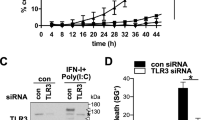Abstract
p95 is a putative signal transduction protein of ∼95 kDa that contains multiple tyrosine residues that are conserved from yeast to human, a Src phosphorylation consensus sequence and a proline-rich C-terminus that binds SH3-domains. Previous studies have established that mammalian p95 is physically associated with proteins that regulate apoptotic induction and cell transformation; however, it is unclear whether p95 is a positive or negative regulator in these processes. Moreover, a p95 partner protein has been localized at both focal adhesions and actin-cytoskeletons in rat astrocytes. However, there is no evidence that mammalian p95 has roles in regulating cell adhesion or morphology. In this study, we examined the effects of p95 on the anchorage-independent growth and tumorigenicity of malignant HeLa cells, and on the growth and morphology of non-transformed NIH3T3 cells. In HeLa cells, p95 overexpression promoted detachment-induced apoptosis (anoikis), inhibited detachment of viable cells from substratum and reduced tumorigenicity. In NIH3T3 cells, p95 overexpression promoted flat cell morphology and slowed cell proliferation, whereas p95 downregulation had opposite effects. These findings indicate that the mammalian p95 is a positive regulator in apoptotic signaling and a negative regulator in cell transformation. They also suggest that p95 has roles in regulating cell adhesion and morphology.
This is a preview of subscription content, access via your institution
Access options
Subscribe to this journal
Receive 50 print issues and online access
$259.00 per year
only $5.18 per issue
Buy this article
- Purchase on Springer Link
- Instant access to full article PDF
Prices may be subject to local taxes which are calculated during checkout






Similar content being viewed by others
References
Aplin AE, Howe AK, Juliano RL . 1999 Curr. Opin. Cell Biol. 11: 737–744
Arai T, Okamoto K, Ishiguro K, Terao K . 1976 Gann 67: 493–503
Assoian RK, Schwartz MA . 2001 Curr. Opin. Genet. Dev. 11: 48–53
Bogler O, Furnari FB, Kindler-Roehrborn A, Sykes VW, Yung R, Huang HJ, Cavenee WK . 2000 Neuro-oncol. 2: 6–15
Braga V . 2000 Nat. Cell. Biol. 2: E182–E184
Bunge R, Glaser L, Lieberman M, Raben D, Salzer J, Whittenberger B, Woolsey T . 1979 J. Supramol. Struct. 11: 175–187
Che S, El-Hodiri H, We C-f, Nelman-Gonzalez M, Weil MM, Etkin LD, Clark D, Kuang J . 1999 J. Biol. Chem. 274: 5522–5531
Che S, Weil MM, Etkin LD, Clark RB, Kuang J . 1997 Biochim. Biophys. Acta 1354: 231–240
Chen B, Borinstein SC, Gillis J, Sykes VW, Bogler O . 2000 J. Biol. Chem. 275: 19275–19281
Danen EH, Yamada KM . 2001 J. Cell. Physiol. 189: 1–13
Fagotto F, Gumbiner GM . 1996 Dev. Biol. 180: 445–454
Krebs J, Klemenz R . 2000 Biochim. Biophys. Acta 1498: 153–161
Kuang J, He G, Huang Z, Khokkar AR, Siddik ZH . 2001 Clin. Cancer Res. 7: 3629–3639
Missotten M, Nichols A, Rieger K, Sadoul R . 1999 Cell Death Differ. 6: 124–129
Negrete-Urtasun S, Denison SH, Arst Jr HN . 1997 J. Bacteriol. 179: 1832–1835
Nickas ME, Yaffe MP . 1996 Mol. Cell. Biol. 16: 2585–2593
Rockwell SC, Kallman RF, Fajardo LF . 1972 J. Natl. Cancer Inst. 49: 735–749
Ruoslahti E, Obrink B . 1996 Exp. Cell. Res. 227: 1–11
Spiryda LB, Colman DR . 1998 J. Cell. Sci. 111: 3253–3260
Vito P, Lacana E, D'Adamio L . 1996 Science 271: 521–525
Vito P, Pellegrini L, Guiet C, D'Adamio L . 1999 J. Biol. Chem. 274: 1533–1540
Wu Y, Pan S, Che S, He G, Nelman-Gonzalez M, Weil MM, Kuang J . 2001 Differentiation 67: 139–153
Acknowledgements
This work was supported by grants awarded to Dr Jian Kuang by the American Cancer Society (RPG-00-071-01-DDC). Hp95 cDNA constructs were sequenced by the DNA Core Facility of UT M.D. Anderson Cancer Center supported by the Core Grant # CA16672. We thank Drs GE Gallick and RB Clark for helpful discussions. We thank Dr Guangan He for assistance in statistical analysis.
Author information
Authors and Affiliations
Corresponding author
Rights and permissions
About this article
Cite this article
Wu, Y., Pan, S., Luo, W. et al. Hp95 promotes anoikis and inhibits tumorigenicity of HeLa cells. Oncogene 21, 6801–6808 (2002). https://doi.org/10.1038/sj.onc.1205849
Received:
Revised:
Accepted:
Published:
Issue Date:
DOI: https://doi.org/10.1038/sj.onc.1205849
Keywords
This article is cited by
-
Overexpression of GATA4 enhances the antiapoptotic effect of exosomes secreted from cardiac colony-forming unit fibroblasts via miRNA221-mediated targeting of the PTEN/PI3K/AKT signaling pathway
Stem Cell Research & Therapy (2020)
-
Extracellular Alix regulates integrin-mediated cell adhesions and extracellular matrix assembly
The EMBO Journal (2008)



